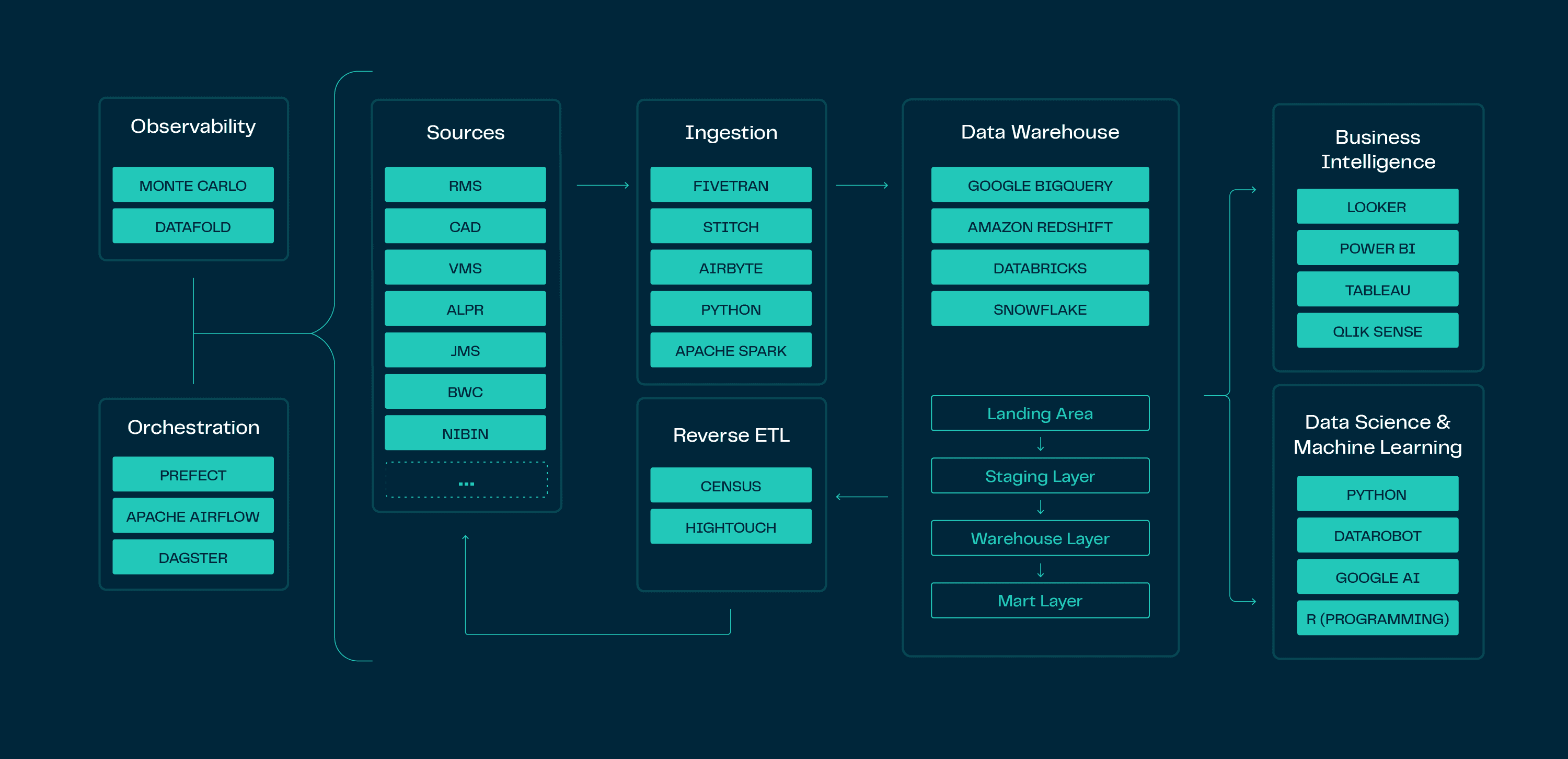Simplifying the modern data stack
Ben Rudolph
October 30, 2024

- The modern data stack uses cloud-based tools to make your organization's information more available and accessible.
- Leveraging this new technology can be a game-changer, but also pricey and complicated.
- Peregrine streamlines the modern data stack, making it easier to use without compromising on its benefits.
The modern data stack enables organizations to employ their increasing data across disparate data stores to great effect. However, the landscape of tools used to implement the different pieces of the data stack is immense and complex, including numerous solutions for orchestrating the data load; extracting, ingesting, and analyzing data; and monitoring health.
Peregrine streamlines the modern data stack without compromising on its advantages. We handle the most challenging aspects ourselves to give your team seamless access to clean, enriched, warehoused data on an integrated, user-friendly platform.
Advantages of the modern data stack
Traditionally, organizations have relied on on-premise servers, proprietary protocols, and hand-rolled integration methods to store, manage, access, and use their data. The modern data stack turned this framework on its head by making data available and accessible through a set of cloud-based tools, each solving a discrete problem.
Now, data-driven organizations might use one tool to orchestrate their data load, another to extract data, and so on and so forth until they've implemented solutions for ingesting, cleaning, and analyzing data and monitoring the health of the overall tech data stack. When combined, these tools collectively make up what we call the modern data stack.
Much of the past decade has been awash with new technologies each promising to manage a different piece of your data stack. Compared to traditional models, this modern paradigm offers significant benefits for data management, such as:
- Enabling an infrastructure that is free from on-premise servers
- Offering infinite scalability
- Prioritizing open and interoperable data formats
- Allowing you to derive insights from an ever-increasing set of data sources
Challenges with the modern data stack

The modern data stack represents a step-change in how we think about and operate on data. However, it also involves making dozens of decisions surrounding which technology to use. We're facing a few unfortunate, yet resounding, realities in the current data ecosystem:
- The best tool is a moving target. The above image gives a snapshot of the tools that make up today's data ecosystem. If you were to create that same image even just a few years ago, many of those tools would have looked different — in fact, some would not have existed yet. It’s safe to say that in a few years, there will be even more players in the market, while more still will have left the market.
- Your infrastructure is only as good as its weakest component. Choosing the right tooling is important. If a piece of your data pipeline isn’t operating correctly, the entire system suffers, making it difficult to depend on and find insights in your data.
- Every tool has its challenges. The inconvenient truth is that behind the marketing, these tools all have rough edges when you dive into the details. This is due in part to the fact that turning your disparate data into actionable information is a deeply challenging problem.
- Maintenance is expensive. Overcoming these hurdles often requires costly teams of engineers, and the maintenance burden of staying up to date on the latest advancements is high.
Problem-solving for those issues takes focus away from what really matters: using your data to make decisions and power your organization.
The Peregrine solution
There are ways for your organization to take part in the data revolution without having to allocate so many resources to technical challenges. For example, Peregrine works on top of your data stack, and our engineering team sweats the details to provide a streamlined, consistent, reliable interface. This provides the insights you need on one intuitive, unified platform while still delivering the full advantages of the modern tech stack.
When you use Peregrine, you can leverage the recent advancements in data architecture without needing to debate whether to use Airflow or Airbyte. We monitor the health of your data pipelines, ingest them into a warehouse, and train your teams on how to uncover insights with our front-end applications. We work tirelessly to capitalize on the latest techniques without disrupting your operations.
Our data platform approach is threefold:
- Unlock unstructured and structured data. Many systems and data platforms focus on bringing in only structured data to feed their systems. We focus on your most valuable datasets and unlock the power of both your unstructured data (for example, PDFs and Word files) and your structured data (for example, SQL and Excel spreadsheets).
- Avoid vendor lock-in. A common concern with platform approaches is vendor lock-in. We want you to choose and continue to use Peregrine because it provides incredible value, not because you're trapped. First, you own your data, always and forever. Second, we provide access to your data through an open API or through SQL connections.
- Ensure security and compliance. Permission controls are infused into the system from the start. Whether you're creating charts or viewing records, you have complete control over which data is visible, down to the property level.
At Peregrine, we understand that managing mission-critical data infrastructure requires more than just advanced technology. It demands reliability, security, and ease of use. Our platform helps you harness the full potential of the modern data stack, without the associated complexities and risks. We built Peregrine so you can focus on your most important objectives while we ensure your data systems are robust, compliant, and efficient.